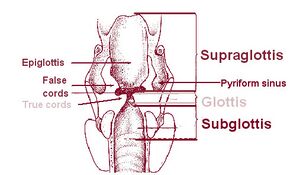Medicine:Pyriform sinus
| Pyriform sinus | |
|---|---|
 Pyriform sinus, a part of hypopharynx | |
 The entrance to the larynx, viewed from behind, with Pyriform sinus labeled at bottom left. | |
| Details | |
| Identifiers | |
| Latin | recessus piriformis, sinus piriformis |
| Anatomical terminology | |
The pyriform sinus (also piriform recess, piriform sinus, piriform fossa, or smuggler's fossa) is a small recess on either side of the laryngeal inlet. It is bounded medially by the aryepiglottic fold, and laterally by the thyroid cartilage and thyrohyoid membrane.[1] The fossae are involved in speech.
Etymology
The term "pyriform," which means "pear-shaped," is also sometimes spelled "piriform".[citation needed]
The term smuggler's fossa comes from its use for smuggling of small items.[2]
Anatomy
Relations
Deep to the mucous membrane of the pyriform fossa lie the recurrent laryngeal nerve as well as the internal laryngeal nerve, a branch of the superior laryngeal nerve.[3] The internal laryngeal nerve supplies sensation to the area, and it may become damaged if the mucous membrane is inadvertently punctured. The pyriform sinus is a subsite of the hypopharynx. This distinction is important for head and neck cancer staging and treatment.[4]
Clinical significance
This sinus is a common place for food particles to become trapped; if foreign material becomes lodged in the piriform fossa of an infant, it may be retrieved nonsurgically. If the area is injured (e.g., by a fish bone), it can give the sensation of food stuck in the subject's throat.[2]
Remnants of the pharyngeal pouches III and IV may extent to the piriform sinus as sinus tracts which are sometimes imprecisely called "fistulas".[5][6] This can result in acute infectious thyroiditis which is more common on the left side of the neck.[7]
References
- ↑ Standring, Susan (2020). Gray's Anatomy: The Anatomical Basis of Clinical Practice (42nd ed.). New York. pp. 709. ISBN 978-0-7020-7707-4. OCLC 1201341621. https://www.worldcat.org/oclc/1201341621.
- ↑ 2.0 2.1 Singh, Vishram (4 March 2014). Textbook of Anatomy Head, Neck, and Brain;. Elsevier Health Sciences. p. 203. ISBN 978-81-312-3627-7. https://books.google.com/books?id=bNTgAwAAQBAJ&pg=PA203.
- ↑ Moore, K.L., & Agur, A.M.R (2007). Essential Clinical Anatomy: Third Edition. Baltimore: Lippincott Williams & Wilkins. ISBN:978-0-7817-6274-8
- ↑ AJCC Cancer Staging Handbook: From the AJCC Cancer Staging Manual, Sixth Edition. Ed. Frederick L. Greene, M.D. page 48.
- ↑ Koch, Bernadette L.; Hamilton, Bronwyn E.; Hudgins, Patricia A.; Harnsberger, H. Ric (22 November 2016). Diagnostic Imaging: Head and Neck E-Book. Elsevier Health Sciences. p. 611. ISBN 978-0-323-44314-2. https://books.google.com/books?id=wgCRDQAAQBAJ&pg=PA611.
- ↑ Lucente, Frank E.; Har-El, Gady (2004). Essentials of Otolaryngology. Lippincott Williams & Wilkins. pp. 281–2. ISBN 978-0-7817-4707-3. https://books.google.com/books?id=m1uW6zW6BvgC&pg=PA281.
- ↑ Gorbach, Sherwood L.; Bartlett, John G.; Blacklow, Neil R. (2004). Infectious Diseases. Lippincott Williams & Wilkins. p. 462. ISBN 978-0-7817-3371-7. https://books.google.com/books?id=91altE1evAsC&pg=PA462.
External links
- Anatomy photo:31:17-0105 at the SUNY Downstate Medical Center - "Pharynx: The Laryngopharynx"
 |

